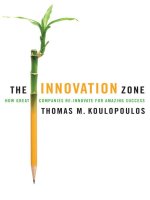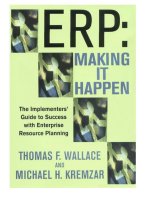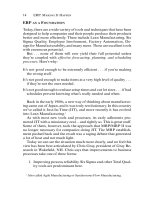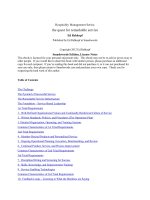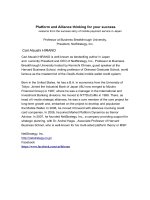project management toolkit the basics for project success project management toolkit
Bạn đang xem bản rút gọn của tài liệu. Xem và tải ngay bản đầy đủ của tài liệu tại đây (2.67 MB, 305 trang )
Project Management Toolkit
This page intentionally left blank
Project Management Toolkit
The Basics for Project Success
Second Edition
Trish Melton
AMSTERDAM • BOSTON • HEIDELBERG • LONDON •
NEW YORK • OXFORD PARIS • SAN DIEGO •
SAN FRANCISCO • SINGAPORE • SYDNEY • TOKYO
Butterworth-Heinemann is an imprint of Elsevier
Butterworth-Heinemann is an imprint of Elsevier
Linacre House, Jordan Hill, Oxford OX2 8DP, UK
30 Corporate Drive, Suite 400, Burlington, MA 01803, USA
First published by IChemE 2005
Second edition 2007
Copyright © 2007, Trish Melton. Published by Elsevier Ltd. All rights reserved
The right of Author Name to be identified as the author of this work has been asserted in accordance
with the Copyright, Designs and Patents Act 1988
No part of this publication may be reproduced, stored in a retrieval system or transmitted in any
form or by any means electronic, mechanical, photocopying, recording or otherwise without the
prior written permission of the publisher
Permissions may be sought directly from Elsevier’s Science & Technology Rights Department in
Oxford, UK: phone (ϩ44) (0) 1865 843830; fax (ϩ44) (0) 1865 853333; email:
Alternatively you can submit your request online by visiting the Elsevier web site at
and selecting Obtaining permission to use Elsevier material
Notice
No responsibility is assumed by the publisher for any injury and/or damage to persons or property as a matter
of products liability, negligence or otherwise, or from any use or operation of any methods, products, instructions
or ideas contained in the material herein. Because of rapid advances in the medical sciences, in particular,
independent verification of diagnoses and drug dosages should be made
British Library Cataloguing in Publication Data
A catalogue record for this book is available from the British Library
Library of Congress Cataloging-in-Publication Data
A catalog record for this book is available from the Library of Congress
ISBN: 978-0-7506-8440-8
For information on all Butterworth-Heinemann publications
visit our web site at books.elsevier.com
Typeset by Charon Tec Ltd (A Macmillan Company), Chennai, India
www.charontec.com
Printed and bound in Great Britain
07 08 09 10 10 9 8 7 6 5 4 3 2 1
About the author
Trish Melton is a project and business change professional who has worked on engineering and nonengineering projects worldwide throughout her career. She works predominantly in the chemicals,
pharmaceuticals and healthcare industries.
She is a chartered Chemical Engineer and a Fellow of the Institution of Chemical Engineers
(IChemE), where she was the founder Chair of the IChemE Project Management Subject Group. She is
a part of the Membership Committee which reviews all applications for corporate membership of the
institution and in 2005 she was elected to the Council (Board of Trustees)
She is an active member of the International Society of Pharmaceutical Engineering (ISPE) where
she serves on the working group in charge of updating ISPE’s Bulk Pharmaceutical Chemicals
Baseline® Guide. She is the founder and Chair of the Project Management Community of Practice
formed in 2005. She has presented on various subjects at ISPE conferences including project
management, quality risk management and lean manufacturing and has also supported ISPE as the
conference leader for project management and pharmaceutical engineering conferences. She is
also the developer and lead trainer for ISPE’s Project Management Training Course. In 2006 the UK
Affiliate recognized Trish’s achievements when she was awarded their Special Member Recognition
Award.
Trish is the Managing Director of MIME Solutions Ltd., an engineering and management consultancy
providing project management, business change management, regulatory, and GMP consulting for
pharmaceutical, chemical, and healthcare clients.
Within her business, Trish is focused on the effective solution of business challenges and these
inevitably revolve around some form of project: whether a capital project, an organizational change
programme or an interim business solution. Trish uses project management on a daily basis to
support the identification of issues for clients and implementation of appropriate, sustainable
solutions.
Good project management equals good business management and Trish continues to research and
adapt best practice project management in a bid to develop, innovate and offer a more agile approach.
v
This page intentionally left blank
About the Project Management
Essentials series
The Project Management Essentials series comprises four titles written by experts in their field and
developed as practical guidelines, suitable as both university textbooks and refreshers/additional
learning for practicing Project Managers.
Project Management Toolkit: The Basics for Project Success
Project Benefits Management: Linking Projects to the Business
Real Project Planning: Developing a Project Delivery Strategy
Managing Project Delivery: Maintaining Control & Achieving Success
This first book provides a general overview with the subsequent titles supplementing the skills and
knowledge gained and expanding the toolkit. The books in the series are supported by an
accompanying website (www.icheme.org/projectmanagement), which delivers blank tool templates
for the reader to download for personal use.
vii
This page intentionally left blank
Foreword
This book has become a reality for a number of reasons:
As an experienced Project Manager I realized that increasingly I was dealing with customers,
sponsors and Project Team members who had no project management experience. Project
Management Toolkit is a direct response to this. For many years I have used the material contained
in this book to develop and train ‘line’ managers, in particular, those who needed the basic skills to
successfully deliver a project they had just been ‘handed’.
As the found Chair of the IChemE Project Management Subject Group (PMSG) and then more
recently a part of the Continuous Professional Development (CPD) and Publications Sub-groups it
was evident that there wasn’t a good entry-level book for those wanting to develop project
management skills at the start of their project management careers.
Project Management Toolkit is an entry-level book and the first in a new series of project management
books developed by members of the IChemE PMSG. The three subsequent books in the series are at a
more detailed level to supplement the skills and knowledge developed in Project Management Toolkit
(see page v for more information).
This second edition of Project Management Toolkit has responded to the excellent feedback from
readers and reviewers and provides some more ‘real’ examples of how the toolkit has been used.
Additionally these new case studies take the reader through every stage of the project and through
every applicable tool.
Although this book is primarily written from the perspective of engineering projects within the
process industries, experiences from both outside of this industry and within different types of
projects have been used. Based on the feedback from some of the Project Managers who have used
this book the two new case studies cover two very different types of project: the capital engineering
project and the business change project (usually revenue expenditure) — demonstrating the generic
use of the toolkit over a wide range of industries and project types.
The Toolkit is specific enough to support Engineering Managers in the delivery of projects within
the process industries, yet generic enough to support
– the Research and Development Managers in developing or launching a new product;
– Business Managers in transforming a business area
– IT Managers in delivering a new computer system
Project management is about people, and this Toolkit emphasizes the criticality of the management
of the ‘soft’ side of projects — the people whose lives may change as a result of a project, the Project
Team members who are key to effective delivery and the sponsors and organizational stakeholders
who ensure, with the Project Manager, that ‘no project is an island’.
ix
This page intentionally left blank
Acknowledgements
When pulling together ideas and experiences into a ‘book’ you become really aware of all the friends,
family and colleagues who have helped you along the way to a greater or smaller extent. You are
equally aware that to individually acknowledge everyone becomes impossible; therefore, I have picked
out a few key ones. . . .
To Andrew, my husband, without whom I would never eat! Life is a project and Andrew is, and will
always be, my critical path.
To all my ‘test’ audiences over the years who have enthusiastically used the tools to challenge
whether they are doing the ‘right’ project and then whether they are doing it ‘right’ — the fact that they
have used the tools on a broad spectrum of project types and sizes within many different industries has
reinforced my view that at some level project management is based on generic principles.
Every good Project Manager needs a team — I am fortunate in having a wide team of colleagues —
particularly Gillian Lawson and Peter Iles-Smith, my Project Management Subject Group (PMSG)
colleagues who, with me, are the IchemE Editorial Team for the Project Management Series of Books.
I also want to thank Arnold Black and Mike Adams who have provided an invaluable ‘sounding board’
for my PM thoughts over the years we have worked together on the PMSG Committee.
Finally you always need ‘live’ Project Teams to test new project management ideas, tools and
processes — AstraZeneca Transformation Projects Group (led by Paul Burke) provided this role during
the development of the first edition. Without them I may have finished the book sooner; however, I just
wouldn’t have had as much fun! I’m thankful for their challenge and their enthusiasm.
I also want to thank Paul Burke, Jeff Wardle and Bill Wilson for continuing to use and test the tools
in this book and allowing me to use example data for the second edition based on their business
change projects within the Strategy Planning and Change Management group within the AZ UK
Business Services organization.
Author’s Note: Although all the case studies presented in this book are based on real experiences they have been
suitably altered so as to maintain complete confidentiality.
xi
This page intentionally left blank
How to use this book
When you pick up this book I am hoping that before you delve into the content you will start by
glancing here.
The structure for this book is based on the concept that every project goes through four value-added
stages — these are described in Chapter 1. Each stage then becomes the subject of its own chapter
(Chapters 3–6).
Chapters 1 and 2 are general introductions and overviews to project management which can be read
at any time to refresh basic concepts that apply to every stage of a project.
Chapters 3–6 are the ‘core chapters’ made up of the following generic sections:
Introduction of basic concepts particular to a project stage.
Presentation of new tools and how to use them.
Demonstration of tool use through short case studies.
Handy hints and further reading.
Each core chapter can ‘stand-alone’ allowing you to dip into any stage and within that stage, any tool
or case study. For each tool the same structure is followed:
The tool is introduced within the context of the stage.
The tool is explained through use of a completed template plus additional notes.
The use of the tool within a project context is detailed.
The blank tool templates are available, in pdf format, on a password protected area within IChemE’s
web site: www.icheme.org/projectmanagement. The password allowing access to the tool templates is
PMTOOLS. The actual format of the pdf cannot be changed but project data, as required by the tool,
can be either input electronically or by hand on printed copies.
Some of the tools are more advanced than others and may be more applicable to larger, more
complex projects. You need to decide what tools you want to use, how you want to use them and then
adapt them for use on your projects.
At the end of each core chapter there is a brief section on further reading, which highlights the
specific book in the PM Essentials series where the project stage is covered to a greater depth.
Additionally the following web sites can be used as a source of further information on project
management (see Footnote 1):
IChemE Project Management Subject Group (PMSG) — www.icheme.org/pmsg — the vision of this
group is to facilitate networking between Project Managers and aspiring Project Managers, of any
discipline, within the process industries; to promote ‘best practice’ project management within the
process industries and to be the ‘voice of project management’ for the IChemE.
Footnote 1: All information regarding project management associations and institutes is available to the public
via their web sites and the author/publisher of this book does not take any liability for its veracity.
xiii
Project Management Toolkit
The Association of Project Management (APM) — www.apm.org.uk — is an independent
professional body based in Europe. APM’s key objective are to develop and promote project
management across all sectors of industry and beyond. A key resource within the APM is the APM
Body of Knowledge.
Project Management Institute (PMI) — www.pmi.org — is a global project management institute
focused on the needs of Project Managers worldwide. It has over 200,000 members representing
125 countries and offers professional development support via its certification programme,
education events and Project Management Body of Knowledge.
International Project Management Association (IPMA) — www.ipma.ch — is the world’s oldest
project management association. It is an international network of national project management
societies and is able to represent these national societies at international level. IPMA actively
promotes ‘the importance of efficient, enterprise-wide project management competencies to
organizations’ and has a certification programme supported by educational events, links to
academia and research.
International Society of Pharmaceutical Engineering Project Management Community of
Practice (ISPE PMCoP) — www.ispe.org/pmcop — the aim of this group is to be a dynamic
forum for professionals working within the pharma industry who have an active interest in
promoting continuous improvement in project management and also to create a body of
knowledge specific to the professional needs of its members. The group encourages discussion
of areas of common interest and provides information of relevance to members through
educational events.
Chapter 7 and 8 are new to this second edition and are provided as complete case studies taking the
reader through every stage of two selected projects:
The Pharma Facility Project — an engineering project example highlighting some of the challenges
in delivering a capital project within a highly regulated environment.
The Business Change Project — an organizational design project highlighting some of the issues
associated with the delivery and sustainability of changes which impact the way in which the
business operates.
And remember . . .
There are many ways to complicate project
management – some valid and others not. This
book introduces some basic tools so that at
each ‘value-added’ stage the aspiring Project
Manager can focus on delivering value.
The greatest compliment made to me by a
client was ‘did we need you?’
The greatest compliment made to me by a
project sponsor was ‘why were there no
problems?’
xiv
It used to be that the best Project Managers
were those that solved the big crises, like
heroes putting out the fire whilst saving the
business. . . . Today this is not success — a great
Project Manager will not allow any inferno —
he’ll smell the smoke way before ignition and
put it out with the help and support of his team
and his stakeholders.
Contents
About the author
v
About the Project Management Essentials series
vii
Foreword
ix
Acknowledgements
xi
How to use this book
1 Introduction
Aims
Management by project
The Project Manager
2 The project life-cycle
What is a project?
What is the project life-cycle?
Why do projects fail?
The ‘hard’ and ‘soft’ side of project management
3 Stage One: why?
Why?
Tool: ‘Why?’ Checklist
Tool: Benefits Hierarchy
Tool: Benefits Specification Table
Tool: Business Case Tool (value-add or not?)
Case study A — if only the ‘Why?’ Checklist had been around then!
Case study B — using the ‘Why?’ Checklist to stop a project
Case study C — using the why tools to justify a project
Handy hints
Further reading
And finally . . .
xiii
1
2
3
5
7
7
7
8
10
13
14
15
20
26
32
37
40
42
50
51
51
xv
Project Management Toolkit
4 Stage Two: how?
How?
Project delivery planning
Tool: ‘How?’ Checklist
Tool: Stakeholder Management Plan
Tool: Table of Critical Success Factors
Tool: RACI Chart
Tool: Control Specification Table
Case study D — if only the ‘How?’ Checklist had been around then!
Case study E — using the ‘How?’ Checklist to re-plan a project
Case study F — using the how tools to plan a project
Handy hints
Further reading
And finally . . .
5 Stage Three: in control?
In control?
Control strategy
Tool: ‘In Control?’ Checklist
Tool: Risk Table and Matrix
Tool: Earned Value
Tool: Project Scorecard
Case study G — if only the ‘In Control?’ Checklist had been around then!
Case study H — using the in control tools to stop a project
Case study I — using the in control tools to review a project
Handy hints
Further reading
And finally . . .
6 Stage Four: benefits realized?
Sustainability
Tool: ‘Benefits Realized?’ Checklist
Tool: Benefits Tracking Tool
Tool: Project Assessment Tool
Tool: Sustainability Checklist
Case study J — if only the ‘Benefits Realized?’ Checklist had been around then!
Case study K — using the benefits realized tools to redevelop a project
Case study L — using the benefits realized tools to review a project
Handy hints
Further reading
And finally . . .
7 Case Study One: the pharma facility project
Situation
Stage One – Business Case Development
xvi
53
53
54
56
64
70
75
79
84
89
94
105
105
106
107
107
108
109
119
124
128
130
134
140
147
147
148
149
150
152
156
160
165
169
172
177
184
184
185
187
190
192
Contents
Stage Two — Project Delivery Planning
Stage Three — Project Delivery
Stage Four — Benefits Realization
8 Case Study Two: the business change project
Situation
Stage One — Business Case Development
Stage Two — Project Delivery Planning
Stage Three — Project Delivery
Stage Four — Benefits Realization
Index
199
211
224
231
235
237
248
264
274
285
xvii
This page intentionally left blank
Introduction
1
Project Management Toolkit is a practical handbook for both career Project Managers and managers
involved with projects intermittently throughout their career.
Organizations are realizing the impact that projects, and therefore project management, can have on
their success.
A project used to be one mechanism that organizations used to deliver benefits, now organizations
are managed by project; this has meant the development of project management competency within
the organization, the Project Team(s) and the individual Project Manager(s).
This book provides a simple tool based resource for each key ‘value-added’ stage in a project and is
intended for use by anybody involved in projects and could form a basis for an organizational project
management system (Figure 1-1).
At the end of each chapter ‘handy hints’ are given as well as details of the specific book in the
IChemE project management series where more information can be sought.
STAGE ONE
STAGE TWO
STAGE THREE
STAGE FOUR
Business
case
development
Project
delivery
planning
Project
delivery
Benefit
delivery
STAGE ONE — Business case development
STAGE THREE — Project delivery
WHY are we doing this project?
Are we delivering this project IN CONTROL?
TOOLS
TOOLS
‘Why?’ Checklist
Benefits Hierarchy
Benefits Specification Table
Business Case Tool
STAGE TWO — Project delivery planning
‘In Control?’ Checklist
Risk Table and Matrix
Earned Value Tool
Project Scorecard
STAGE FOUR — Benefits Delivery
HOW are we going to deliver the WHAT of this
project?
Have we delivered the BENEFITS?
TOOLS
TOOLS
‘How?’ Checklist
Table of Critical Success Factors
RACI Chart
Stakeholder Management Plan
Control Specification Table
‘Benefits Realized?’ Checklist
Benefits Tracking Tool
Project Assessment Tool
Sustainability Checklist
Figure 1-1 Project Management Toolkit overview
1
Project Management Toolkit
Case studies in each chapter illustrate the use of each tool. Blank tool templates are available via
the internet at www.icheme.org/projectmanagement for the readers of this book to use.
Aims
The primary aim of this book is to develop a practical, usable resource which can be picked up and used
on ‘day 1’. It provides the reader with education, tools and the confidence to successfully manage projects.
Figure 1-2 shows an input–process–output diagram:
Inputs — lists the inputs to the development of this book.
Process — summarizes the contents of this book.
Outputs — lists the outputs from this book from the perspective of the reader.
Project Management Toolkit introduces:
Simple but effective tools which can be used to support the Project Manager in increasing the
‘certainty of outcome’.
A pragmatic process to the development of your project, from the early stages of idea development
through to the delivery of the benefits.
Apart from the tools and the processes, this book also aims to define more clearly the role of the
Project Manager in today’s projects and the increasing importance of generic project management
competency within an organization.
INPUTS
To Project
Management Toolkit
PROCESS
Project
Management Toolkit
Tried and tested project
management tools
Project management tools that have
been used by many Project Managers
on many different projects
Project management expertise
Input from Project Managers based on
their successful delivery of projects
over many years
OUTPUTS
From Project
Management Toolkit
‘Starter’ project
management education
Project management
principles
A sample of project
management tools and
techniques
Case studies
Initial entry level education for the
reader who is an aspiring Project
Manager
‘Starter’ project
management toolkit
A set of project management tools that
the reader can use, adapt and add to
Handy hints
Project management expertise
Detailed case study experiences which
show what can go wrong on projects
and also what makes for a successful
project
Further reading
Figure 1-2 This book’s IPO (input–process–output)
2
Project success
An increase in reader confidence in
their ability to successfully manage
projects
Introduction
Although this book is primarily aimed at Project Managers within the process industries it is equally
applicable to Project Managers in other disciplines because project management is a generic organizational
competency which can be used:
Within any type of project — by use of transferable project management skills and knowledge.
Within any type of organization — by adding strategic business value to an organization.
Management by project
Each year millions of pounds are spent around the globe delivering projects. Therefore effective
project management is critical for today’s organizations.
Consider the organizational impact of:
Delivering a project late.
Delivering a project over budget.
Delivering a project which doesn’t meet scope requirements.
For some projects the impact of not delivering within these three basic parameters can have
disastrous effects on an organization.
Delivering a project late
Some projects have a defined and fixed target completion date; if this date is missed then the
organization may not be able to realize the benefits. For example a manufacturing facility which will
support the launch of a new pharmaceutical product for the treatment of respiratory disease needs to be
complete in time for the winter launch of the drug and certainly before the launch of a competitor drug.
Delivering a project over budget
A project budget is a key part of the ‘organizational contract’; the benefits which will be realized are
directly related to the investment monies approved. For example a project to automate a production
process is approved so that the production capacity increases; if the investment is greater than
budgeted then the organization will not realize the expected benefits.
Delivering a project that doesn’t meet the scope requirements (quantity, quality,
functionality)
A project delivers a specific amount of scope at a specified level of quality with certain functional
requirements; if this is not delivered then the completed project may not be able to deliver the
anticipated benefits. For example a project to improve production efficiency if not capable of enabling
the business benefits to be realized, and for those benefits to be tracked, cannot be considered as
successfully supporting the organization.
Organizational project management
Recent research by the Engineering Construction Industry Association (ECIA) was able to demonstrate
the financial impact of good and poor project management:
Effective use of best practice project management yielded an average cost saving of 5–10%.
Poor use of project management gave an average cost growth of 10%.
3
Project Management Toolkit
Apart from showing that the use of best practice project management was able to decrease the
average percentage cost growth, the data also showed a decrease in variability — the use of best
practice project management increased the ability to forecast the outcome. It could be said that:
Excellent Project Managers have the capability to bring projects in on time and within budget —
average or poor Project Managers may not!
Recent management theorists, and project management practitioners, have proposed a new cultural
paradigm that relies on project management competency as a core skill for an organization:
Organizations are moving from managing projects to management by projects.
A change in the way these organizations do business relies on project management competence at
all levels in the organization as a key success factor, that is to say within Project Teams and the
business management team at all levels.
Organizations are realizing the impact that projects, and therefore project management, can have on
their success:
A project used to be one mechanism that organizations used to deliver benefits — now projects &
project management are integral to normal business operation.
This has meant the development of two further facets of project management competency:
Organizational project management excellence.
Project Team excellence.
Therefore the competency of the Project Manager is not the only determining factor. It is suggested
that if you have a project focused organization, with excellent technical ability and effective teamwork
then you still need an excellent Project Manager to achieve an excellent outcome — to exceed your
objectives.
Figure 1-3 outlines the various elements that a project-focused organization should consider:
Organizational support system.
Project Manager support system.
Project management processes.
Project Office
Corporate
Support
Organization
Competency
Framework
Knowledge
Framework
ORGANIZATIONAL
SUPPORT SYSTEM
PROJECT MANAGER
SUPPORT SYSTEM
Project Management
Community
Competency
framework
Career
ladder
PROJECT MANAGEMENT
PROCESSES
Tools and Techniques
Project
management
principles and
standards
Team
competency
framework
Figure 1-3 An organizational approach to project management
4
Introduction
Organizational support system
This is a system to support the management of the organization ‘by project’. It supports the
development of a generic project management competency for all individuals in that
organization.
Project Manager support system
This is a system to support the development of project management excellence within that
organization — within the career Project Managers. Career ladders may be linked to formally
recognized professional qualifications, to specific education providers or to specific project
management institutions such as the APM (Association of Project Management).
Project management processes
This is a collection of the appropriate project management tools for that organization and is thus
support for the entire organization, including career Project Managers. The overall roadmap for any
project would be defined here.
This book introduces basic tools and techniques, which could form the basis for the development of
robust organizational project management processes.
The Project Manager
Project Managers are those individuals who remain accountable for the achievement of the
project objectives and who also ensure alignment of the project objectives with the business objectives
via use of an organizational project sponsor. This role is described in more detail in Chapter 3.
Traditionally Project Managers have focused on ‘the project triangle’ and all the tools, techniques
and processes have been about the delivery of this triangle — the management and control of scope
(quantity, quality and functionality), cost and time (Figure 1-4).
Figure 1-4 The project triangle
5
Project Management Toolkit
Table 1-1 Project Managers
Career Project Manager
Temporary project involvement
The role
Accountable for projects and possibly
for programmes of projects
Developed over a number of years with
practical project experience
Line Manager typically delivering one project
and then returning to line management role
(project is usually linked to this role)
Addressing an immediate project need
Potentially has limited project experience but
valuable background and understanding of the
organizational and/or technical issues
Development needs
Structured, progressive continuing
training and development
In-depth expert level training
Potential to have a formal project
management qualification
Fast introduction to project management
processes, tools and techniques
Guidance on ‘where to get help’
Coaching
Main outcome
Individual experts available to an
organization for professional
project delivery
Individual basic project management
understanding
Improved organizational project management
competence
Now Project Managers need to understand the environment in which the project is to be delivered.
As well as having a robust control strategy they must equally have a link to the organization. This has
lead to an increasing awareness of ‘benefits management’, which is described in detail in Chapter 3.
Therefore Project Managers are considered to be:
Accountable for the achievement of the project objectives (cost, scope and time), for example
through an appropriate project management control methodology.
Responsible for the delivery of the benefits enablers (the things that allow the benefits to be
realized), for example by understanding the link between the project and the business.
Responsible for developing the Project Team and managing the project stakeholders (anyone
involved with or impacted by the project) — through good people management.
Project management competence can be developed in two ways within an organization (Table 1-1).
As organizations become more aware of the importance of projects and project management they
have realized the importance of project management competence.
6


